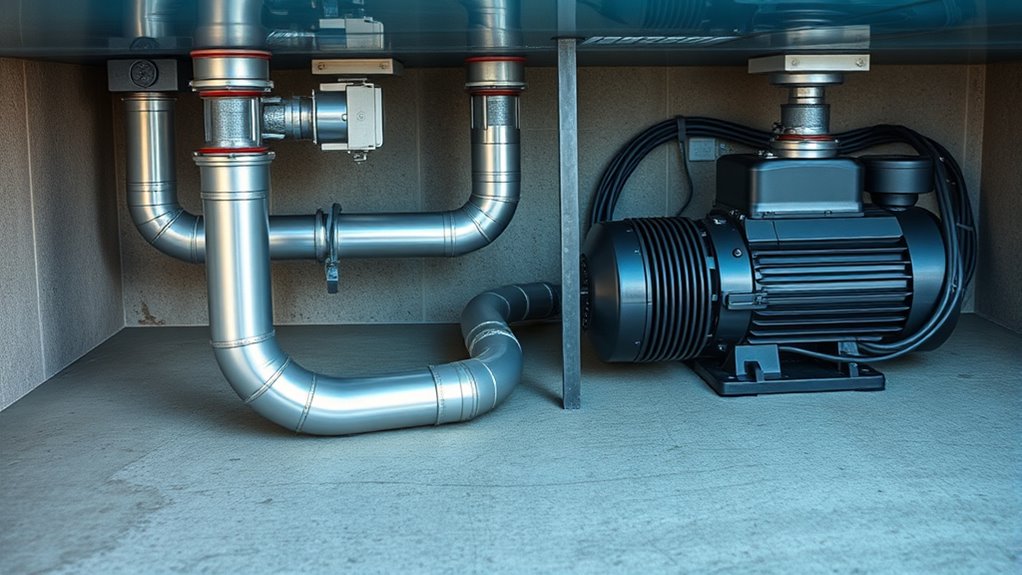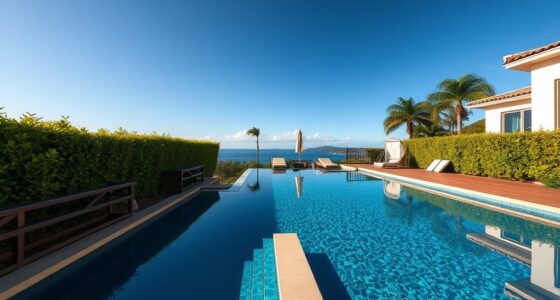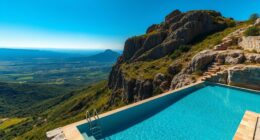To set up your endless pool, you need durable hoses, a reliable pump, and a filtration system suitable for your size. Make certain your electrical system includes a dedicated 120V or 240V circuit with a GFCI breaker for safety. Proper placement of the pump, filter, and return jets promotes good water circulation. Adhere to local codes and safety standards to protect everyone. Keep exploring to discover how to optimize your plumbing and power setup even further.
Key Takeaways
- Install a dedicated 120V or 240V circuit with a GFCI breaker for safety and sufficient amperage.
- Use durable, corrosion-resistant hoses to connect the pump, filter, and return jets securely.
- Position the pump and filter system on a stable, level surface close to the pool for optimal water flow.
- Strategically place return jets and drains to ensure efficient water circulation and prevent dead spots.
- Ensure all electrical wiring complies with safety standards, minimizing length and including clear labeling for easy maintenance.
Essential Plumbing Components for Your Endless Pool

To guarantee your Endless Pool operates smoothly, it’s essential to have the right plumbing components in place. First, make certain you have durable hoses designed for water circulation, allowing for efficient flow between the pump and the pool. You’ll also need a reliable pump to power water movement, which is crucial for filtration and jet functions. A filter system is important to keep the water clean and clear, preventing algae and debris buildup. Proper fittings and valves help you control water flow and make maintenance easier. Consider incorporating a skimmer or overflow drain to manage surface debris effectively. Finally, use corrosion-resistant materials to withstand constant exposure to water and chlorine, making sure your plumbing setup remains reliable and long-lasting.
Electrical Requirements and Power Supply Considerations
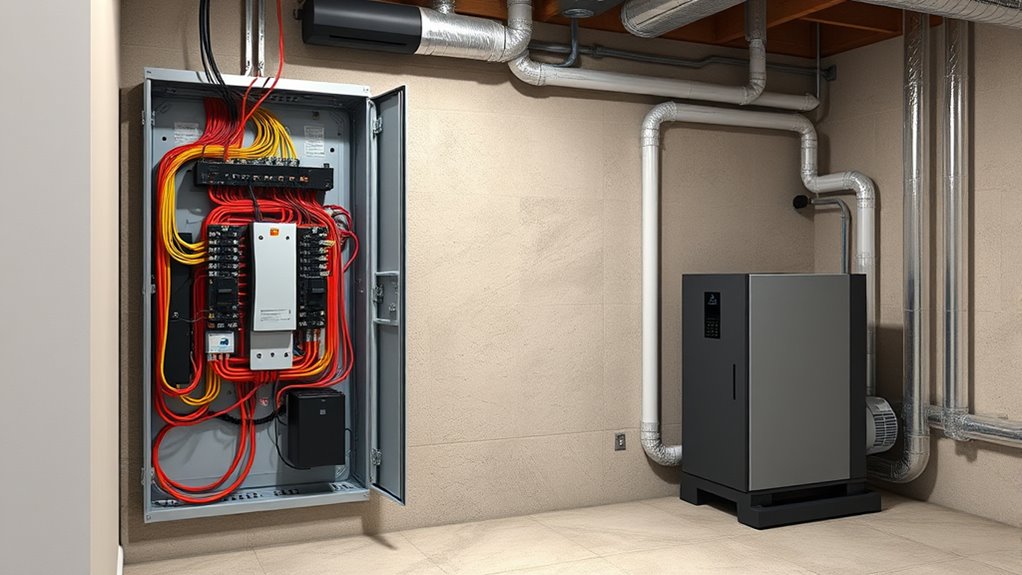
Ensuring your Endless Pool has the right electrical setup is vital for safe and reliable operation. You’ll need a dedicated circuit with proper voltage and amperage to handle your pool’s power demands. Check your pool’s specifications to determine whether it requires a standard 120V outlet or a higher 240V supply. Installing a GFCI (Ground Fault Circuit Interrupter) breaker is essential for safety, protecting against electrical shocks. Keep in mind that your electrical supply should be close enough to minimize voltage drop and wiring costs. Use the table below to compare key electrical considerations: Understanding electrical requirements can help prevent potential hazards and ensure proper functioning.
| Consideration | Details |
|---|---|
| Voltage Requirements | 120V or 240V, depending on your pool model |
| Circuit Capacity | Make sure dedicated circuit has sufficient amperage |
| Safety Devices | Install GFCI breaker for protection |
| Wiring Distance | Keep wiring as short as possible for efficiency |
Pump and Filtration System Setup

Properly setting up your pump and filtration system is essential for maintaining clean and clear water in your Endless Pool. Start by choosing a pump with the right flow rate for your pool size. Position the pump on a stable, level surface near the pool’s filtration inlet. Connect the pump to the filtration system using high-quality, corrosion-resistant hoses, guaranteeing all connections are tight to prevent leaks. Install a filter suitable for your pool’s volume—sand, cartridge, or DE filters are common options. Make sure the filter is accessible for maintenance. Once assembled, double-check all connections, then power on the system to verify proper operation. Regularly clean or replace the filter to keep your water pristine and ensure the pump runs efficiently. Incorporating proper equipment maintenance ensures longevity and optimal performance of your system.
Water Circulation and Drainage Solutions
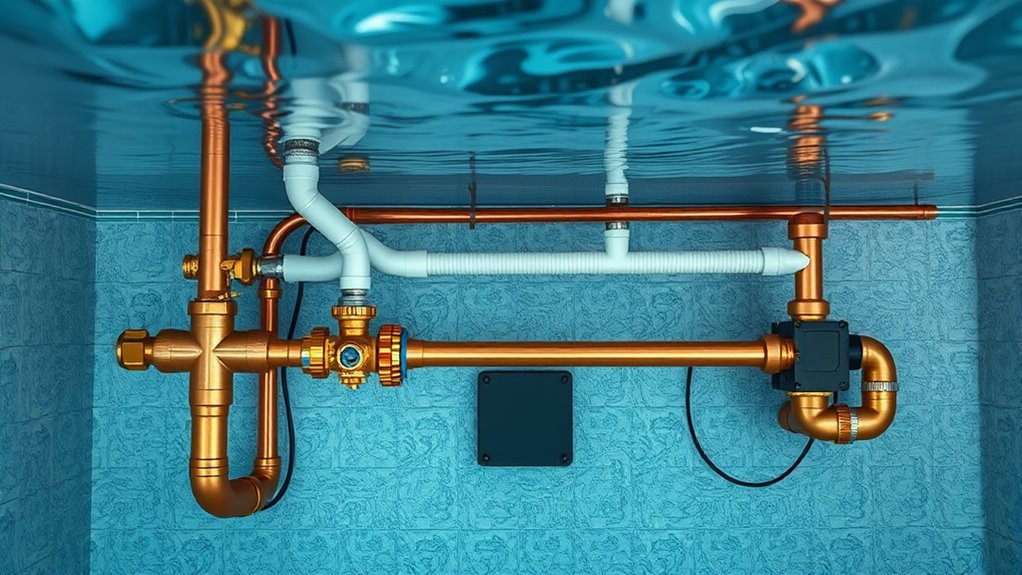
Efficient water circulation in your Endless Pool keeps water moving smoothly, preventing stagnation and distributing chemicals evenly. Proper drainage ensures that debris and excess water are removed quickly, maintaining water quality. To achieve this, install strategically placed return jets to promote circulation and a reliable drain system for quick removal of excess water. Consider the flow rate and placement to prevent dead spots where water stagnates. Using a combination of pumps and filters helps maintain clarity and hygiene. Proper planning ensures your Endless Pool stays fresh and inviting. Additionally, understanding water flow rate is crucial for optimizing system performance and ensuring consistent water movement throughout the pool.
Safety Measures and Code Compliance

To keep your Endless Pool safe and compliant with local regulations, you need to understand and implement essential safety measures and adhere to building codes. Install proper fencing or barriers around the pool to prevent accidental falls, especially if children or pets are nearby. Make sure your electrical wiring meets safety standards, using GFCI outlets to prevent electrical shocks. Regularly inspect your equipment for wear and tear, and maintain proper chemical levels to ensure water safety. Obtain any necessary permits before installation and follow local codes for plumbing and electrical setups. Label control panels clearly and keep safety equipment, like life rings or poles, accessible. Staying proactive about safety and compliance helps protect everyone and keeps your Endless Pool a fun, secure retreat. Additionally, understanding vape juice expiration and proper storage can help prevent potential hazards related to chemical deterioration.
Frequently Asked Questions
How Long Does It Typically Take to Install the Plumbing for an Endless Pool?
Installing the plumbing for your endless pool usually takes about one to three days, depending on your site’s complexity. You’ll need to coordinate with professionals who can handle the excavation, pipe installation, and connection to your existing system. Make sure you have all permits in place beforehand. During installation, stay available to answer questions and guarantee the process runs smoothly. Once done, testing the system takes a few additional hours.
Can I Connect My Pool’s Power Supply to an Existing Electrical System?
Did you know that most residential electrical systems can handle an endless pool’s power needs? You can often connect your pool’s power supply to an existing system, but it’s vital to check your circuit capacity and local codes first. Consult a licensed electrician to make certain your setup is safe and compliant. This way, you avoid overloading circuits and guarantee reliable operation without unnecessary upgrades.
What Are the Typical Maintenance Costs for the Pump and Filtration System?
You’ll typically spend around $100 to $300 annually on pump and filtration maintenance. Regularly, you’ll need to replace filters every 6 to 12 months and occasionally service the pump to guarantee peak performance. Keep an eye on wear and tear, and clean the system to prevent costly repairs. Proper maintenance extends the lifespan of your equipment and keeps your pool running smoothly all year round.
Are There Specific Drainage Options Recommended for Different Yard Types?
Think of your yard as a garden needing tailored drainage solutions. For sandy soils, opt for perforated pipes with gravel beds to prevent water pooling. Clay-heavy grounds benefit from French drains that channel water away efficiently. If your yard slopes, consider a swale to direct runoff. Customizing drainage is like fitting a puzzle piece—ensure your yard stays dry and your pool remains in perfect harmony.
What Permits or Inspections Are Required for Installing an Endless Pool?
You’ll likely need a building permit before installing your endless pool. Check with your local building department to see if inspections are required during or after installation. Some areas also require electrical permits for wiring and power setup. Make sure to provide detailed plans and comply with safety codes. Failing to get the proper permits can lead to fines or having to remove your pool, so double-check local regulations early on.
Conclusion
Getting your endless pool set up is like crafting a perfect symphony; every component must work in harmony. By understanding the plumbing, electrical needs, and safety measures, you’ll create a seamless oasis of relaxation. Think of your setup as the backbone of your aquatic sanctuary, holding everything steady and smooth. With the right planning, your pool will flow effortlessly, turning your backyard into a tranquil haven that’s as reliable as the tide itself.

